In Vitro Fermentation Characteristics of Purified Short-Chain Inulin and Inulin Neoseries Oligosaccharides Produced from Red Onions
Abstract
1. Introduction
2. Materials and Methods
2.1. Preparation of Short-Chain Inulin and Inulin Neoseries Oligosaccharides
2.2. Volunteer Recruitment and Fecal Sample Collection
2.3. In Vitro Fecal Batch Fermentation
2.4. Extraction of Genomic DNA and 16S rRNA Gene Amplicon Sequencing
2.5. Bioinformatic Analysis
2.6. High Performance Liquid Chromatography
2.7. Determination of the Ability of Lactococcus sp. In Fermentation of Neokestose, 1-Kestose, and Nystose
2.8. Statistical Analysis
3. Results and Discussion
3.1. Fermentability of Short-Chain Inulin and Inulin Neoseries Oligosaccharides
3.2. Changes in Bacterial Composition and Diversity
3.3. Substrate Specificity of Lactococcus Lactis Toward Neokestose, 1-Kestose, and Nystose
3.4. Production of Lactic Acid and Short-Chain Fatty Acids
4. Conclusions
Supplementary Materials
Author Contributions
Funding
Institutional Review Board Statement
Informed Consent Statement
Data Availability Statement
Conflicts of Interest
References
- Leangnim, N.; Shank, L.; Chanawanno, K.; Khanongnuch, C.; Kanpiengjai, A. Biotechnological production and current feasible applications of neokestose: A review. Carbohydr. Polym. Technol. Appl. 2025, 10, 100798. [Google Scholar] [CrossRef]
- Duan, W.; Ji, W.; Wei, Y.; Zhao, R.; Chen, Z.; Geng, Y.; Jing, F.; Wang, X. Separation and purification of fructo-oligosaccharide by high-speed counter-current chromatography coupled with precolumn derivatization. Molecules 2018, 23, 381. [Google Scholar] [CrossRef]
- Dou, Y.; Yu, X.; Luo, Y.; Chen, B.; Ma, D.; Zhu, J. Effect of fructooligosaccharides supplementation on the gut microbiota in human: A systematic review and meta-analysis. Nutrients 2022, 14, 3298. [Google Scholar] [CrossRef]
- Stewart, M.L.; Timm, D.A.; Slavin, J.L. Fructooligosaccharides exhibit more rapid fermentation than long-chain inulin in an in vitro fermentation system. Nutr. Res. 2008, 28, 329–334. [Google Scholar] [CrossRef]
- Rossi, M.; Corradini, C.; Amaretti, A.; Nicolini, M.; Pompei, A.; Zanoni, S.; Matteuzzi, D. Fermentation of fructooligosaccharides and inulin by bifidobacteria: A comparative study of pure and fecal cultures. Appl. Environ. Microbiol. 2005, 71, 6150–6158. [Google Scholar] [CrossRef]
- Lim, J.S.; Lee, J.H.; Kang, S.W.; Park, S.W.; Kim, S.W. Studies on production and physical properties of neo-FOS produced by co-immobilized Penicillium citrinum and neo-fructosyltransferase. Eur. Food Res. Technol. 2007, 225, 457–462. [Google Scholar] [CrossRef]
- Aisara, J.; Wongputtisin, P.; Deejing, S.; Maneewong, C.; Unban, K.; Khanongnuch, C.; Kosma, P.; Blaukopf, M.; Kanpiengjai, A. Potential of inulin-fructooligosaccharides extract produced from red onion (Allium cepa var. viviparum (Metz) Mansf.) as an alternative prebiotic product. Plants 2021, 10, 2401. [Google Scholar]
- Wongputtisin, P.; Ramaraj, R.; Unpaprom, Y.; Kawaree, R.; Pongtrakul, N. Raffinose family oligosaccharides in seed of Glycine max cv. Chiang Mai60 and potential source of prebiotic substances. Int. J. Food Sci. Technol. 2015, 50, 1750–1756. [Google Scholar] [CrossRef]
- Khan, S.; Waliullah, S.; Godfrey, V.; Khan, M.A.W.; Ramachandran, R.A.; Cantarel, B.L.; Behrendt, C.; Peng, L.; Hooper, L.V.; Zaki, H. Dietary simple sugars alter microbial ecology in the gut and promote colitis in mice. Sci. Transl. Med. 2020, 12, eaay6218. [Google Scholar] [CrossRef]
- Fajstova, A.; Galanova, N.; Coufal, S.; Malkova, J.; Kostovcik, M.; Cermakova, M.; Pelantova, H.; Kuzma, M.; Sediva, B.; Hudcovic, T.; et al. Diet rich in simple sugars promotes pro-inflammatory response via gut microbiota alteration and TLR4 signaling. Cells 2020, 9, 2701. [Google Scholar] [CrossRef]
- Wongsanittayarak, J.; Leangnim, N.; Unban, K.; Khanongnuch, C.; Lumyong, S.; Wongputtisin, P.; Kanpiengjai, A. Integrated enzymatic hydrolysis of crude red onion extract and yeast treatment for production and purification of short-chain inulin and inulin neoseries oligosaccharides. J. Agric. Food Res. 2024, 18, 101353. [Google Scholar] [CrossRef]
- Popov, I.V.; Koopmans, B.; Venema, K. Modulation of human gut microbiota by linear and branched fructooligosaccharides in an in vitro colon model (TIM-2). J. Appl. Microbiol. 2024, 135, lxae170. [Google Scholar] [CrossRef] [PubMed]
- Geng, J.; Ni, Q.; Sun, W.; Li, L.; Feng, X. The links between gut microbiota and obesity and obesity related diseases. Biomed. Pharmacother. 2022, 147, 112678. [Google Scholar] [CrossRef]
- Aisara, J.; Wongsanittayarak, J.; Leangnim, N.; Utama, K.; Sangthong, P.; Sriyotai, W.; Mahatheeranont, S.; Phongthai, S.; Unban, K.; Lumyong, S.; et al. Purification and characterization of crude fructooligosaccharides extracted from red onion (Allium cepa var. viviparum) by yeast treatment. Microb. Cell Fact. 2024, 23, 17. [Google Scholar] [CrossRef] [PubMed]
- Jitnarin, N.; Kosulwat, V.; Rojroongwasinkul, N.; Boonpraderm, A.; Haddock, C.K.; Poston, W.S. Prevalence of overweight and obesity in Thai population: Results of the national thai food consumption survey. Eat. Weight Disord.-Stud. Anorex. 2011, 16, e242–e249. [Google Scholar] [CrossRef]
- Hernandez-Hernandez, O.; Sanz, M.L.; Kolida, S.; Rastall, R.A.; Moreno, F.J. In vitro fermentation by human gut bacteria of proteolytically digested caseinomacropeptide nonenzymatically glycosylated with prebiotic carbohydrates. J. Agric. Food Chem. 2011, 59, 11949–11955. [Google Scholar] [CrossRef]
- Magoč, T.; Salzberg, S.L. FLASH: Fast length adjustment of short reads to improve genome assemblies. Bioinformatics 2011, 27, 2957–2963. [Google Scholar] [CrossRef]
- Bokulich, N.A.; Subramanian, S.; Faith, J.J.; Gevers, D.; Gordon, J.I.; Knight, R.; Mills, D.A.; Caporaso, J.G. Quality-filtering vastly improves diversity estimates from Illumina amplicon sequencing. Nat. Methods 2013, 10, 57–59. [Google Scholar] [CrossRef]
- Edgar, R.C.; Haas, B.J.; Clemente, J.C.; Quince, C.; Knight, R. UCHIME improves sensitivity and speed of chimera detection. Bioinformatics 2011, 27, 2194–2200. [Google Scholar] [CrossRef] [PubMed]
- Segata, N.; Izard, J.; Waldron, L.; Gevers, D.; Miropolsky, L.; Garrett, W.S.; Huttenhower, C. Metagenomic biomarker discovery and explanation. Genome Biol. 2011, 12, R60. [Google Scholar] [CrossRef]
- Benjamini, Y.; Hochberg, Y. Controlling the false discovery rate: A practical and powerful approach to multiple testing. J. R. Stat. Soc. Ser. B-Stat. Methodol. 1995, 57, 289–300. [Google Scholar] [CrossRef]
- Sheu, D.-C.; Chang, J.-Y.; Chen, Y.-J.; Lee, C.-W. Production of high-purity neofructooligosaccharides by culture of Xanthophyllomyces dendrorhous. Bioresour. Technol. 2013, 132, 432–435. [Google Scholar] [CrossRef]
- Kanpiengjai, A.; Nuntikaew, P.; Wongsanittayarak, J.; Leangnim, N.; Khanongnuch, C. Isolation of efficient xylooligosaccharides-fermenting probiotic lactic acid bacteria from ethnic pickled bamboo shoot products. Biology 2022, 11, 638. [Google Scholar] [CrossRef] [PubMed]
- Chisti, Y. Batt, C.A., Tortorello, M.L., Eds.; Fermentation (Industrial)|Basic Considerations. In Encyclopedia of Food Microbiology (Second Edition); Academic Press: Oxford, UK, 2014; pp. 751–761. [Google Scholar]
- García Mendez, D.F.; Sanabria, J.; Wist, J.; Holmes, E. Effect of operational parameters on the cultivation of the gut microbiome in continuous bioreactors inoculated with feces: A systematic review. J. Agric. Food Chem. 2023, 71, 6213–6225. [Google Scholar] [CrossRef]
- Singh, P.; Gupta, S.K.; Kundu, A.; Grover, M.; Saha, S. Role of fructooligosaccharides in promoting beneficial gut bacteria: A Prebiotic perspective. Food Biosci. 2025, 63, 105726. [Google Scholar] [CrossRef]
- Le Chatelier, E.; Nielsen, T.; Qin, J.; Prifti, E.; Hildebrand, F.; Falony, G.; Almeida, M.; Arumugam, M.; Batto, J.-M.; Kennedy, S.; et al. Richness of human gut microbiome correlates with metabolic markers. Nature 2013, 500, 541–546. [Google Scholar] [CrossRef]
- Palmas, V.; Pisanu, S.; Madau, V.; Casula, E.; Deledda, A.; Cusano, R.; Uva, P.; Vascellari, S.; Loviselli, A.; Manzin, A.; et al. Gut microbiota markers associated with obesity and overweight in Italian adults. Sci. Rep. 2021, 11, 5532. [Google Scholar] [CrossRef]
- Parnell, J.A.; Reimer, R.A. Prebiotic fiber modulation of the gut microbiota improves risk factors for obesity and the metabolic syndrome. Gut Microbes 2012, 3, 29–34. [Google Scholar] [CrossRef] [PubMed]
- Al-Sheraji, S.H.; Ismail, A.; Manap, M.Y.; Mustafa, S.; Yusof, R.M.; Hassan, F.A. Prebiotics as functional foods: A review. J. Funct. Food. 2013, 5, 1542–1553. [Google Scholar] [CrossRef]
- Liu, S.; Lai, X.; Xie, Q.; Wang, Z.; Pan, Y.; Wang, Q.; Zhang, Z. Holo-omics analysis reveals the influence of gut microbiota on obesity indicators in Jinhua pigs. BMC Microbiol. 2023, 23, 322. [Google Scholar] [CrossRef]
- Adak, A.; Khan, M.R. An insight into gut microbiota and its functionalities. Cell. Mol. Life Sci. 2019, 76, 473–493. [Google Scholar] [CrossRef] [PubMed]
- Ma, J.; Piao, X.; Mahfuz, S.; Long, S.; Wang, J. The interaction among gut microbes, the intestinal barrier and short chain fatty acids. Anim. Nutr. 2022, 9, 159–174. [Google Scholar] [CrossRef] [PubMed]
- Lynch, S.V.; Pedersen, O. The human intestinal microbiome in health and disease. N. Engl. J. Med. 2016, 375, 2369–2379. [Google Scholar] [CrossRef]
- Magne, F.; Gotteland, M.; Gauthier, L.; Zazueta, A.; Pesoa, S.; Navarrete, P.; Balamurugan, R. The firmicutes/bacteroidetes ratio: A relevant marker of gut dysbiosis in obese patients? Nutrients 2020, 12, 1474. [Google Scholar] [CrossRef]
- Karačić, A.; Renko, I.; Krznarić, Ž.; Klobučar, S.; Liberati Pršo, A.-M. The association between the firmicutes/bacteroidetes ratio and body mass among european population with the highest proportion of adults with obesity: An observational follow-up study from croatia. Biomedicines 2024, 12, 2263. [Google Scholar] [CrossRef]
- Isenring, J.; Bircher, L.; Geirnaert, A.; Lacroix, C. In vitro human gut microbiota fermentation models: Opportunities, challenges, and pitfalls. Microbiome Res. Rep. 2023, 2, 2. [Google Scholar] [CrossRef]
- Larsen, J.M. The immune response to Prevotella bacteria in chronic inflammatory disease. Immunology 2017, 151, 363–374. [Google Scholar] [CrossRef]
- Xu, S.; Yin, W.; Zhang, Y.; Lv, Q.; Yang, Y.; He, J. Foes or friends? bacteria enriched in the tumor microenvironment of colorectal cancer. Cancer 2020, 12, 372. [Google Scholar] [CrossRef] [PubMed]
- Mills, S.; Ross, R.P.; Coffey, A. Fuquay, J.W., Ed.; Lactic acid bacteria|Lactococcus lactis. In Encyclopedia of Dairy Sciences (Second Edition); Academic Press: San Diego, CA, USA, 2011; pp. 132–137. [Google Scholar]
- Abbas, R.; Chakkour, M.; Zein El Dine, H.; Obaseki, E.F.; Obeid, S.T.; Jezzini, A.; Ghssein, G.; Ezzeddine, Z. General overview of Klebsiella pneumonia: Epidemiology and the role of siderophores in Its pathogenicity. Biology 2024, 13, 78. [Google Scholar] [CrossRef]
- Zhao, Y.; Wang, P.; Wang, D.; Zhao, W.; Wang, J.; Ge, Z.; Liu, Y.; Zhao, X. Gut microbiota and metabolic profile affected by pectic domains during in vitro rat fecal fermentation: A comparative study between different glycans rich in pectic monosaccharides. Carbohydr. Polym. 2025, 356, 123365. [Google Scholar] [CrossRef]
- Pi, X.-E.; Fu, H.; Yang, X.-X.; Yu, Z.-C.; Teng, W.-L.; Zhang, Y.; Ye, X.-W.; Quan, H.H.; Lu, L.-Z.; Liu, W. Bacterial, short-chain fatty acid and gas profiles of partially hydrolyzed guar gum in vitro fermentation by human fecal microbiota. Food Chem. 2024, 430, 137006. [Google Scholar] [CrossRef]
- Cassol, I.; Ibañez, M.; Bustamante, J.P. Key features and guidelines for the application of microbial alpha diversity metrics. Sci. Rep. 2025, 15, 622. [Google Scholar] [CrossRef] [PubMed]
- Hernández-Tasco, A.J.; Tronchini, R.A.; Apaza-Castillo, G.A.; Hosaka, G.K.; Quiñones, N.R.; Goulart, M.C.; Fantinatti-Garboggini, F.; Salvador, M.J. Diversity of bacterial and fungal endophytic communities presents in the leaf blades of Sinningia magnifica, Sinningia schiffneri and Sinningia speciosa from different cladus of Gesneriaceae family: A comparative analysis in three consecutive years. Microbiol. Res. 2023, 271, 127365. [Google Scholar] [CrossRef] [PubMed]
- Nagendra, H. Opposite trends in response for the Shannon and Simpson indices of landscape diversity. Appl. Geogr. 2002, 22, 175–186. [Google Scholar] [CrossRef]
- Peters, B.A.; Shapiro, J.A.; Church, T.R.; Miller, G.; Trinh-Shevrin, C.; Yuen, E.; Friedlander, C.; Hayes, R.B.; Ahn, J. A taxonomic signature of obesity in a large study of American adults. Sci. Rep. 2018, 8, 9749. [Google Scholar] [CrossRef]
- Pinart, M.; Dötsch, A.; Schlicht, K.; Laudes, M.; Bouwman, J.; Forslund, S.K.; Pischon, T.; Nimptsch, K. Gut microbiome composition in obese and non-obese persons: A systematic review and meta-analysis. Nutrients 2022, 14, 12. [Google Scholar] [CrossRef] [PubMed]
- Afzaal, M.; Saeed, F.; Shah, Y.A.; Hussain, M.; Rabail, R.; Socol, C.T.; Hassoun, A.; Pateiro, M.; Lorenzo, J.M.; Rusu, A.V.; et al. Human gut microbiota in health and disease: Unveiling the relationship. Front. Microbiol. 2022, 13, 999001. [Google Scholar] [CrossRef]
- Bañares, C.; Paterson, S.; Gómez-Garre, D.; Ortega-Hernández, A.; Sánchez-González, S.; Cueva, C.; de la Fuente, M.Á.; Hernández-Ledesma, B.; Gómez-Cortés, P. Modulation of gut microbiota and short-chain fatty acid production by simulated gastrointestinal digests from microalga Chlorella vulgaris. Int. J. Mol. Sci. 2025, 26, 2754. [Google Scholar] [CrossRef]
- O’May, G.A.; Reynolds, N.; Macfarlane, G.T. Effect of pH on an in vitro model of gastric microbiota in enteral nutrition patients. Appl. Environ. Microbiol. 2005, 71, 4777–4783. [Google Scholar] [CrossRef]
- Średnicka, P.; Roszko, M.Ł.; Popowski, D.; Kowalczyk, M.; Wójcicki, M.; Emanowicz, P.; Szczepańska, M.; Kotyrba, D.; Juszczuk-Kubiak, E. Effect of in vitro cultivation on human gut microbiota composition using 16S rDNA amplicon sequencing and metabolomics approach. Sci. Rep. 2023, 13, 3026. [Google Scholar] [CrossRef]
- Ma, K.L.; Kei, N.; Yang, F.; Lauw, S.; Chan, P.L.; Chen, L.; Cheung, P.C.K. In vitro fermentation characteristics of fungal polysaccharides derived from Wolfiporia cocos and their effect on human fecal microbiota. Foods 2023, 12, 4014. [Google Scholar] [CrossRef]
- Lozupone, C.; Knight, R. UniFrac: A new phylogenetic method for comparing microbial communities. Appl. Environ. Microbiol. 2005, 71, 8228–8235. [Google Scholar] [CrossRef] [PubMed]
- Liu, X.; Mao, B.; Gu, J.; Wu, J.; Cui, S.; Wang, G.; Zhao, J.; Zhang, H.; Chen, W. Blautia-a new functional genus with potential probiotic properties? Gut Microbes 2021, 13, 1875796. [Google Scholar] [CrossRef]
- Ozato, N.; Saito, S.; Yamaguchi, T.; Katashima, M.; Tokuda, I.; Sawada, K.; Katsuragi, Y.; Kakuta, M.; Imoto, S.; Ihara, K.; et al. Blautia genus associated with visceral fat accumulation in adults 20–76 years of age. npj Biofilms Microbiomes 2019, 5, 28. [Google Scholar] [CrossRef]
- Kelly, D.; Yang, L.; Pei, Z. Gut microbiota, fusobacteria, and colorectal cancer. Diseases 2018, 6, 109. [Google Scholar] [CrossRef]
- Huh, J.-W.; Roh, T.-Y. Opportunistic detection of Fusobacterium nucleatum as a marker for the early gut microbial dysbiosis. BMC Microbiol. 2020, 20, 208. [Google Scholar] [CrossRef] [PubMed]
- Xu, X.; Fu, H.; Quan, H.; Li, Y.; Chen, Q.; Qu, D.; Pi, X. Effects of fructooligosaccharides and Lactobacillus reuteri on the composition and metabolism of gut microbiota in students. Food Funct. 2025, 16, 1562–1575. [Google Scholar] [CrossRef] [PubMed]
- Jeong, H.; Hwang, U.-S.; Choi, H.; Park, Y.-S. Assessing the anti-obesity potential of Lactococcus lactis subsp. lactis CAB701: Modulation of adipocyte differentiation and lipid metabolism in in vitro and in vivo Models. Probiotics Antimicrob. Proteins 2025, 17, 1203–1216. [Google Scholar]
- Yu, P.; Zhao, Y.; Jiang, Y.; Yang, Y.; Liu, X.; Zhang, H.; Zhao, J.; Lee, Y.-k.; Zhang, H.; Chen, W. Capacity of soybean carbohydrate metabolism in Leuconostoc mesenteroides, Lactococcus lactis and Streptococcus thermophilus. Food Biosci. 2021, 44, 101381. [Google Scholar] [CrossRef]
- Cui, Y.; Wang, M.; Zheng, Y.; Miao, K.; Qu, X. The carbohydrate metabolism of Lactiplantibacillus plantarum. Int. J. Mol. Sci. 2021, 22, 13452. [Google Scholar] [CrossRef]
- Saulnier, D.M.; Molenaar, D.; de Vos, W.M.; Gibson, G.R.; Kolida, S. Identification of prebiotic fructooligosaccharide metabolism in Lactobacillus plantarum WCFS1 through microarrays. Appl. Environ. Microbiol. 2007, 73, 1753–1765. [Google Scholar] [CrossRef]
- Kaplan, H.; Hutkins, R.W. Fermentation of fructooligosaccharides by lactic acid bacteria and bifidobacteria. Appl. Environ. Microbiol. 2000, 66, 2682–2684. [Google Scholar] [CrossRef]
- Yao, D.; Wu, M.; Dong, Y.; Ma, L.; Wang, X.; Xu, L.; Yu, Q.; Zheng, X. In vitro fermentation of fructooligosaccharide and galactooligosaccharide and their effects on gut microbiota and SCFAs in infants. J. Funct. Food 2022, 99, 105329. [Google Scholar] [CrossRef]
- Fusco, W.; Lorenzo, M.B.; Cintoni, M.; Porcari, S.; Rinninella, E.; Kaitsas, F.; Lener, E.; Mele, M.C.; Gasbarrini, A.; Collado, M.C.; et al. Short-chain fatty-acid-producing bacteria: Key components of the human gut microbiota. Nutrients 2023, 15, 2211. [Google Scholar] [CrossRef] [PubMed]
- Pei, F.; Li, W.; Ni, X.; Sun, X.; Yao, Y.; Fang, Y.; Yang, W.; Hu, Q. Effect of cooked rice with added fructo-oligosaccharide on faecal microorganisms investigated by in vitro digestion and fermentation. Food Sci. Human Wellness 2023, 12, 662–668. [Google Scholar] [CrossRef]
- Geirnaert, A.; Steyaert, A.; Eeckhaut, V.; Debruyne, B.; Arends, J.B.A.; Van Immerseel, F.; Boon, N.; Van de Wiele, T. Butyricicoccus pullicaecorum, a butyrate producer with probiotic potential, is intrinsically tolerant to stomach and small intestine conditions. Anaerobe 2014, 30, 70–74. [Google Scholar] [CrossRef]
- Singh, V.; Lee, G.; Son, H.; Koh, H.; Kim, E.S.; Unno, T.; Shin, J.H. Butyrate producers, “The Sentinel of Gut”: Their intestinal significance with and beyond butyrate, and prospective use as microbial therapeutics. Front. Microbiol. 2022, 13, 1103836. [Google Scholar] [CrossRef]
- Abdugheni, R.; Wang, W.-Z.; Wang, Y.-J.; Du, M.-X.; Liu, F.-L.; Zhou, N.; Jiang, C.-Y.; Wang, C.-Y.; Wu, L.; Ma, J.; et al. Metabolite profiling of human-originated Lachnospiraceae at the strain level. iMeta 2022, 1, e58. [Google Scholar] [CrossRef]
- Li, Y.; Faden, H.S.; Zhu, L. The response of the gut microbiota to dietary changes in the first two years of life. Front. Pharmacol. 2020, 11, 334. [Google Scholar] [CrossRef]
- Sun, X.; Zhang, Z.; Hu, J. Isolation, probiotic characterization and whole-genome sequencing of gut Faecalibacterium prausnitzii. Hum. Nutr. Metab. 2025, 40, 200315. [Google Scholar] [CrossRef]
- Buckel, W. Energy conservation in fermentations of anaerobic bacteria. Front. Microbiol. 2021, 12, 703525. [Google Scholar] [CrossRef]
- Forwood, D.L.; Holman, D.B.; Meale, S.J.; Chaves, A.V. Ensiled mixed vegetables enriched carbohydrate metabolism in heterofermentative lactic acid bacteria. Fermentation 2022, 8, 699. [Google Scholar] [CrossRef]
- Rios-Covian, D.; Salazar, N.; Gueimonde, M.; de los Reyes-Gavilan, C.G. Shaping the metabolism of intestinal Bacteroides population through diet to improve human health. Front. Microbiol. 2017, 7, 376. [Google Scholar] [CrossRef]
- Qayyum, N.; Shuxuan, W.; Yantin, Q.; Ruiling, W.; Wang, S.; Ismael, M.; Lü, X. Characterization of short-chain fatty acid-producing and cholesterol assimilation potential probiotic lactic acid bacteria from Chinese fermented rice. Food Biosci. 2023, 52, 102404. [Google Scholar] [CrossRef]
- Muñoz-Tamayo, R.; Laroche, B.; Walter, E.; Doré, J.; Duncan, S.H.; Flint, H.J.; Leclerc, M. Kinetic modelling of lactate utilization and butyrate production by key human colonic bacterial species. FEMS Microbiol. Ecol. 2011, 76, 615–624. [Google Scholar] [CrossRef]
- Aiello, A.; Pizzolongo, F.; De Luca, L.; Blaiotta, G.; Aponte, M.; Addeo, F.; Romano, R. Production of butyric acid by different strains of Lactobacillus plantarum (Lactiplantibacillus plantarum). Int. Dairy J. 2023, 140, 105589. [Google Scholar] [CrossRef]
- Özcelik, S.; Kuley, E.; Özogul, F. Formation of lactic, acetic, succinic, propionic, formic and butyric acid by lactic acid bacteria. LWT 2016, 73, 536–542. [Google Scholar] [CrossRef]
- Tabasco, R.; Fernández de Palencia, P.; Fontecha, J.; Peláez, C.; Requena, T. Competition mechanisms of lactic acid bacteria and bifidobacteria: Fermentative metabolism and colonization. LWT 2014, 55, 680–684. [Google Scholar] [CrossRef]
- Du, Z.; Bi, Y.; Li, J.; Xu, Z.; Ding, J.; Huang, M.; Zhang, M.; Ma, D.; Wang, H.; Liu, Z.; et al. Impact of fructooligosaccharides on gut microbiota and microbial metabolites in gestational diabetes mellitus: An in vitro fermentation model study. J. Funct. Food 2025, 127, 106740. [Google Scholar] [CrossRef]
- Wang, Y.; Liu, J.; Long, Y.; Yao, H.; Schols, H.A.; de Vos, P.; Bai, W.; Tian, L. Enzymatic modification of pomelo pectins for shaping the gut microbiota to a healthy pattern. Food Hydrocoll. 2024, 152, 109939. [Google Scholar] [CrossRef]
- Kaewsaen, R.; Wichienchot, S.; Thayanukul, P.; Charoensiddhi, S.; Chanput, W.P. Chemical profile and in vitro gut microbiota modulation of wild edible mushroom Phallus atrovolvatus fruiting body at different maturity stages. Nutrients 2024, 16, 2553. [Google Scholar] [CrossRef] [PubMed]


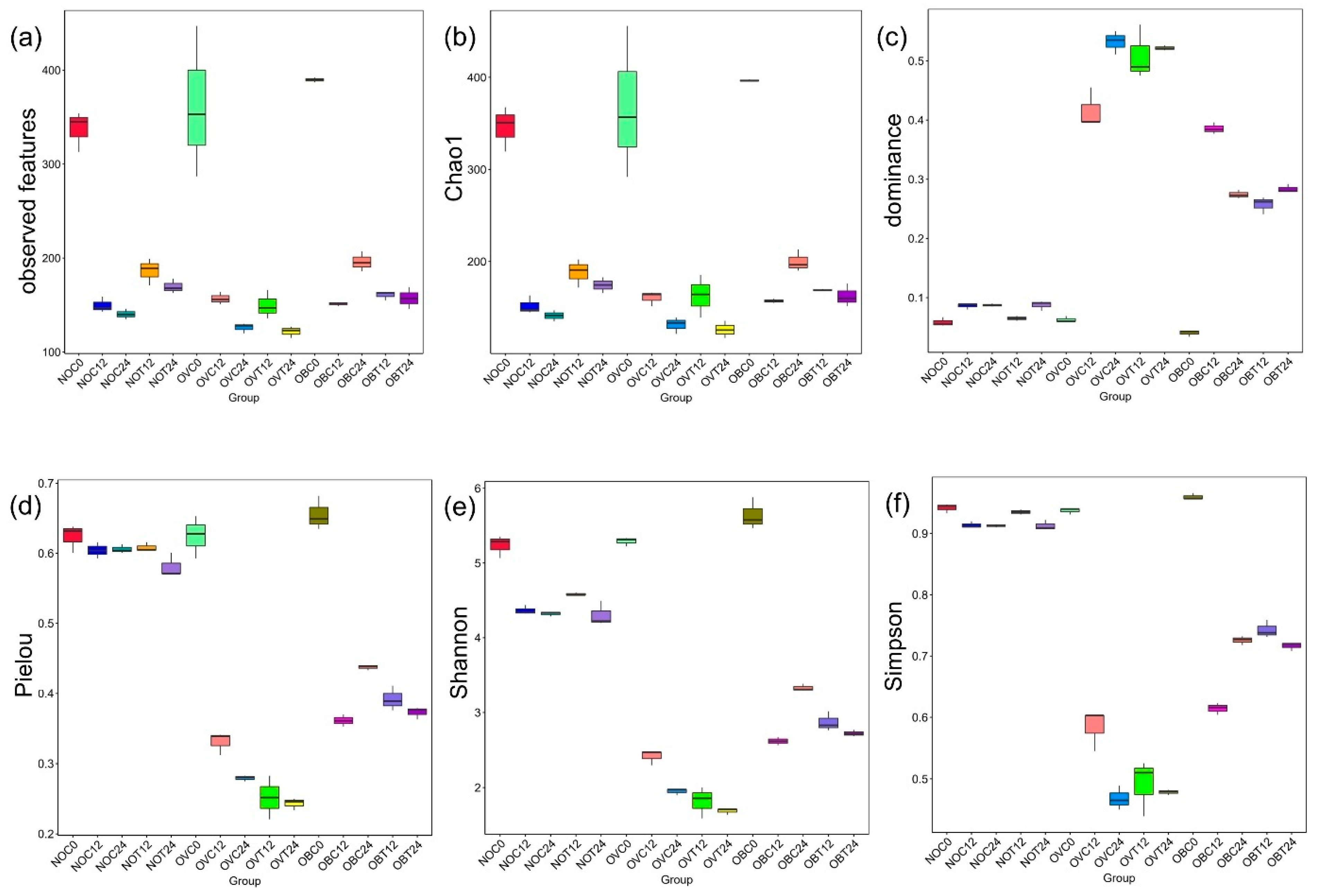
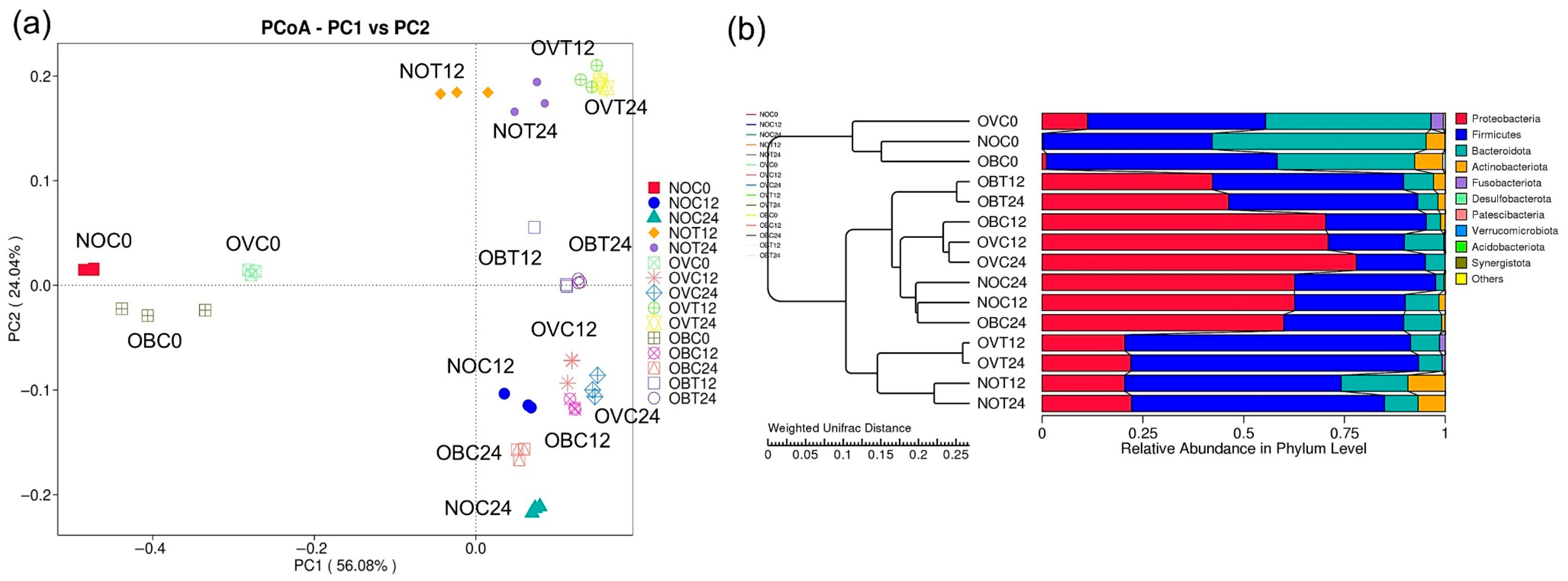
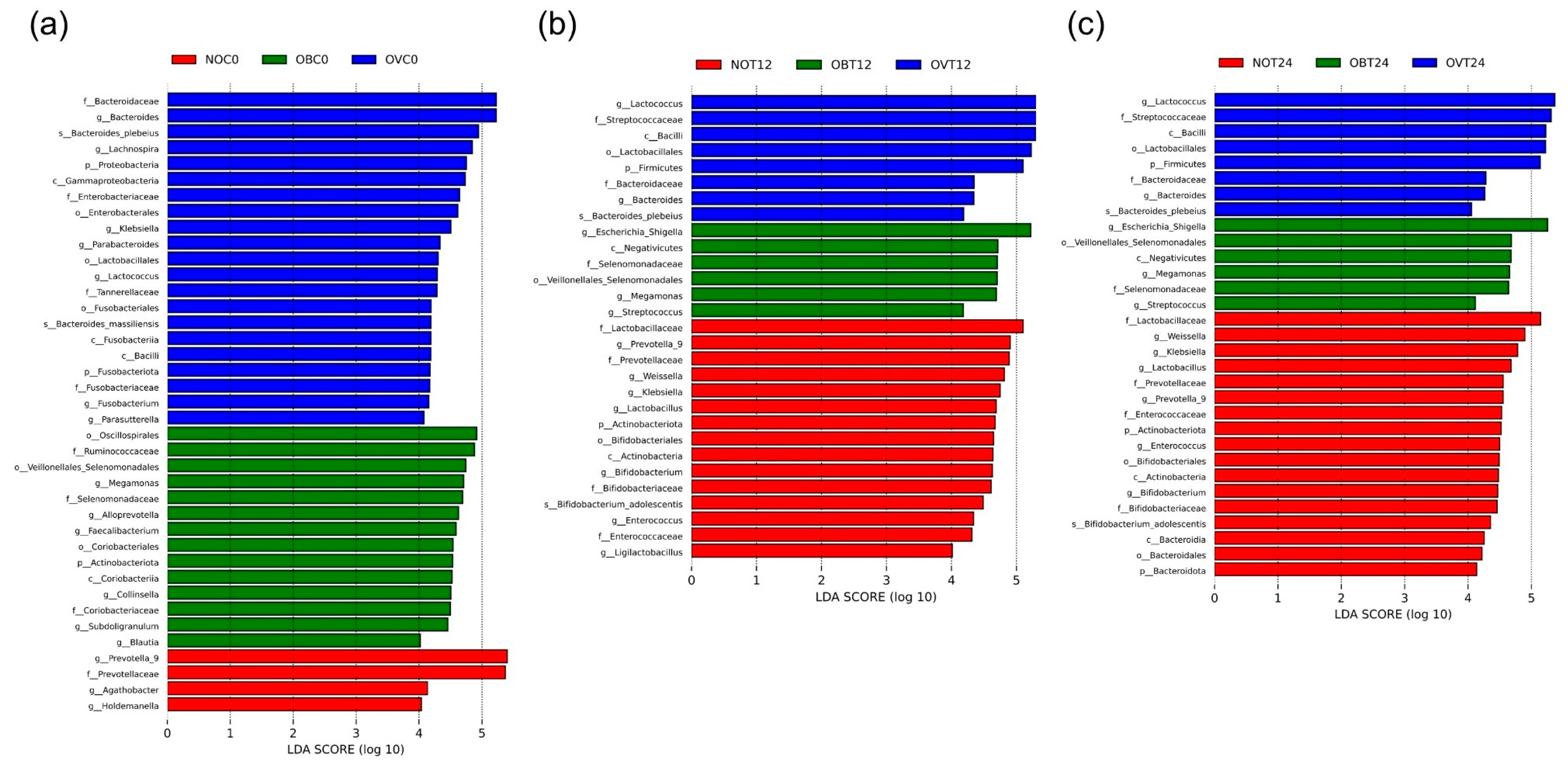
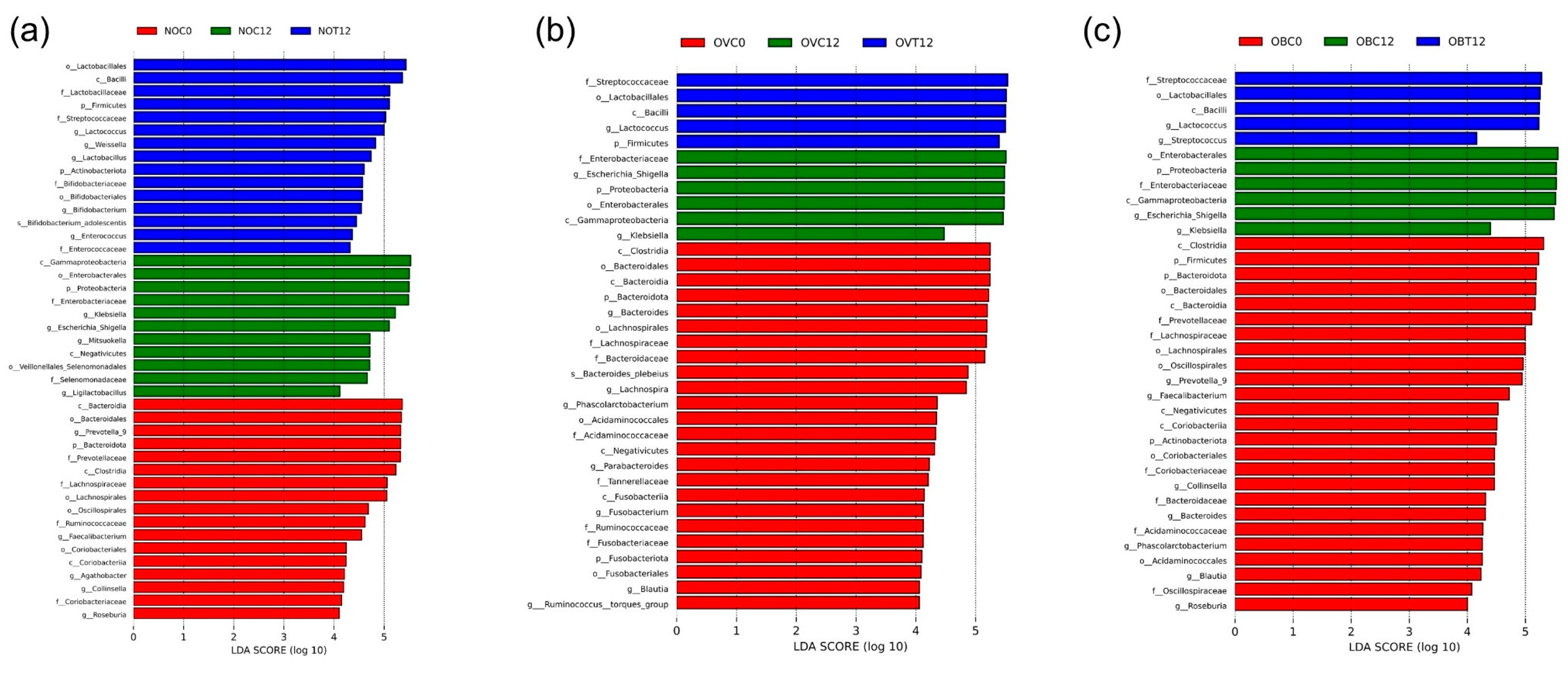
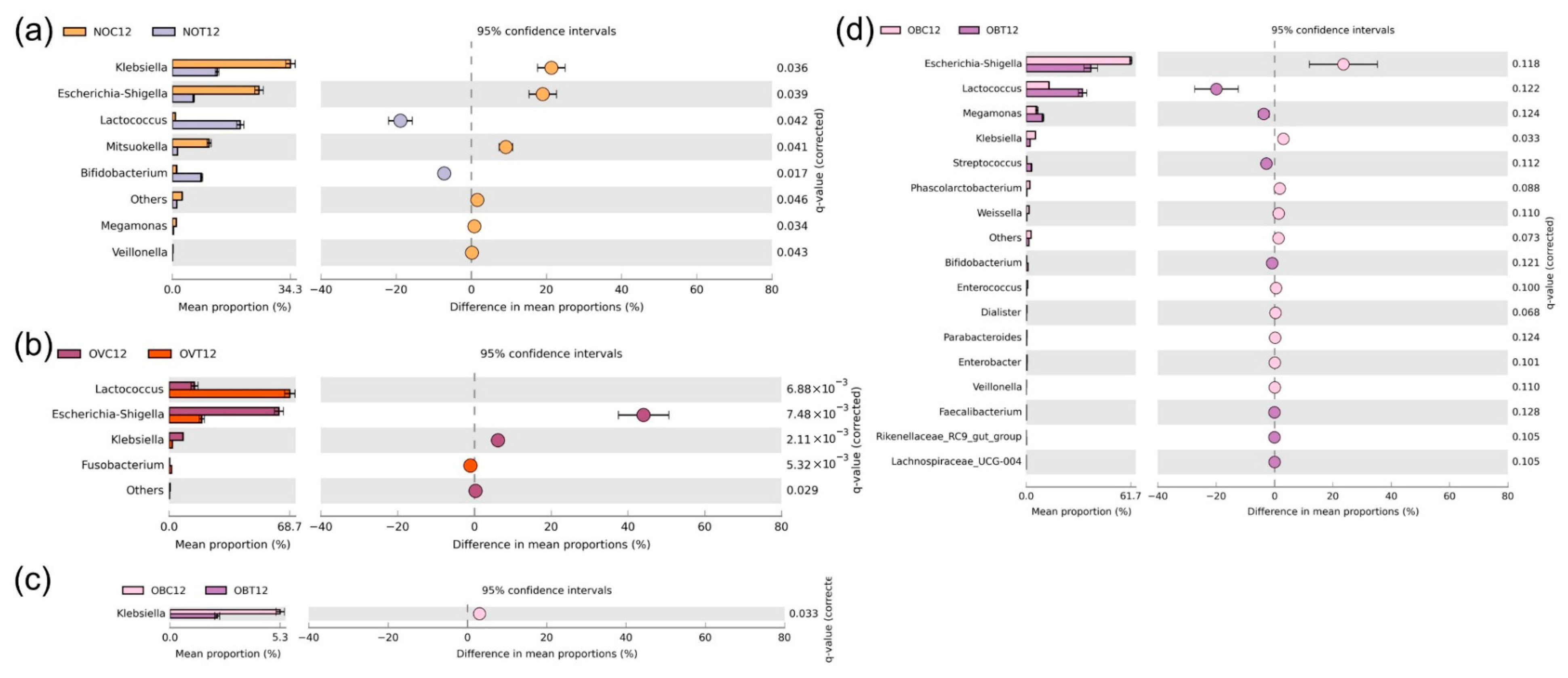

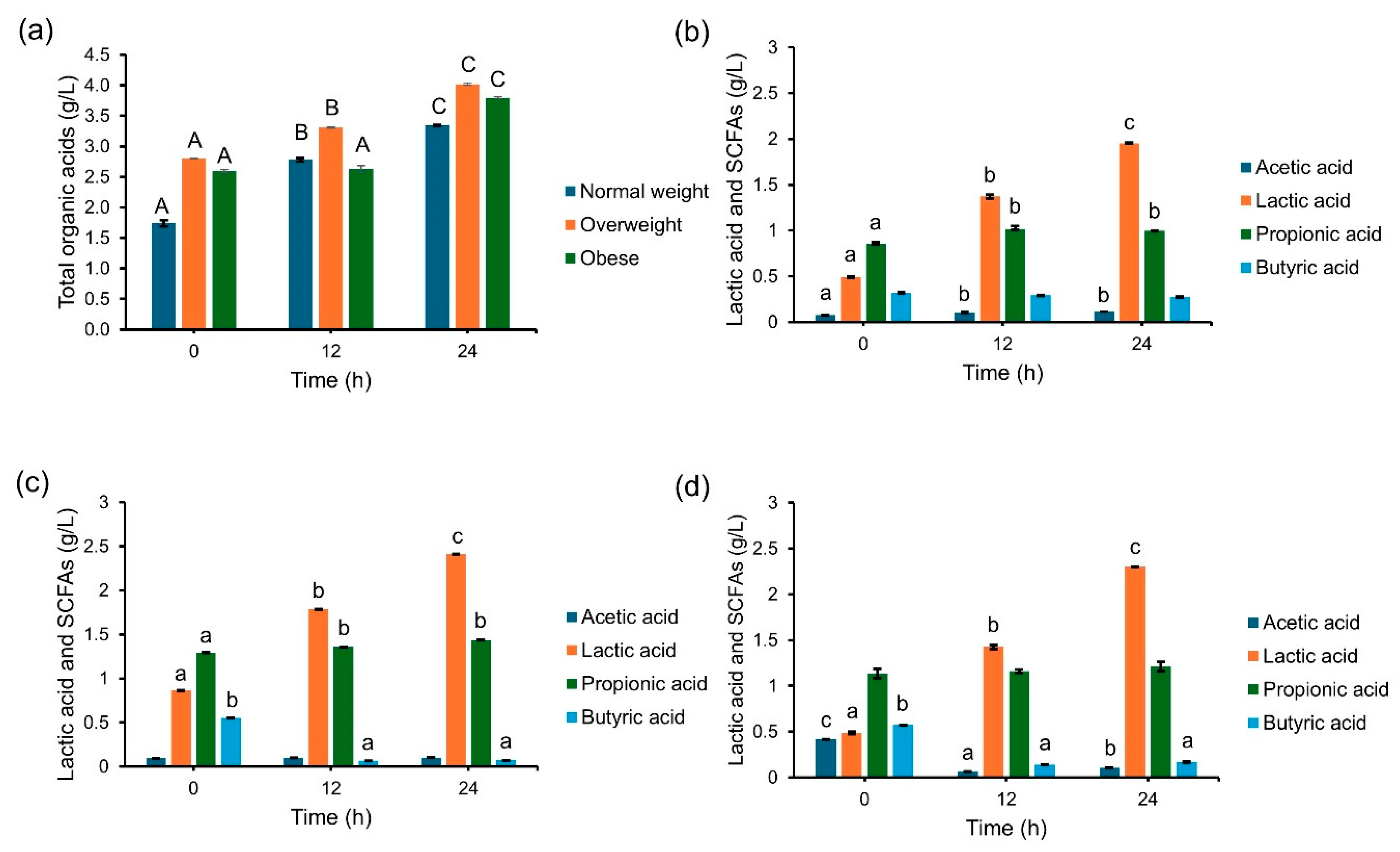
| Subject | Control | Treatment | |||
|---|---|---|---|---|---|
| 0 h | 12 h | 24 h | 12 h | 24 h | |
| NO | NOC0 | NOC12 | NOC24 | NOT12 | NOT24 |
| OV | OVC0 | OVC12 | OVC24 | OVT12 | OVT24 |
| OB | OBC0 | OBC12 | OBC24 | OBT12 | OBT24 |
Disclaimer/Publisher’s Note: The statements, opinions and data contained in all publications are solely those of the individual author(s) and contributor(s) and not of MDPI and/or the editor(s). MDPI and/or the editor(s) disclaim responsibility for any injury to people or property resulting from any ideas, methods, instructions or products referred to in the content. |
© 2025 by the authors. Licensee MDPI, Basel, Switzerland. This article is an open access article distributed under the terms and conditions of the Creative Commons Attribution (CC BY) license (https://creativecommons.org/licenses/by/4.0/).
Share and Cite
Wongsanittayarak, J.; Kanpiengjai, A.; Leangnim, N.; Soyprasert, S.; Unban, K.; Lumyong, S.; Khanongnuch, C.; Wongputtisin, P. In Vitro Fermentation Characteristics of Purified Short-Chain Inulin and Inulin Neoseries Oligosaccharides Produced from Red Onions. Foods 2025, 14, 2804. https://doi.org/10.3390/foods14162804
Wongsanittayarak J, Kanpiengjai A, Leangnim N, Soyprasert S, Unban K, Lumyong S, Khanongnuch C, Wongputtisin P. In Vitro Fermentation Characteristics of Purified Short-Chain Inulin and Inulin Neoseries Oligosaccharides Produced from Red Onions. Foods. 2025; 14(16):2804. https://doi.org/10.3390/foods14162804
Chicago/Turabian StyleWongsanittayarak, Jirat, Apinun Kanpiengjai, Nalapat Leangnim, Supachawadee Soyprasert, Kridsada Unban, Saisamorn Lumyong, Chartchai Khanongnuch, and Pairote Wongputtisin. 2025. "In Vitro Fermentation Characteristics of Purified Short-Chain Inulin and Inulin Neoseries Oligosaccharides Produced from Red Onions" Foods 14, no. 16: 2804. https://doi.org/10.3390/foods14162804
APA StyleWongsanittayarak, J., Kanpiengjai, A., Leangnim, N., Soyprasert, S., Unban, K., Lumyong, S., Khanongnuch, C., & Wongputtisin, P. (2025). In Vitro Fermentation Characteristics of Purified Short-Chain Inulin and Inulin Neoseries Oligosaccharides Produced from Red Onions. Foods, 14(16), 2804. https://doi.org/10.3390/foods14162804






